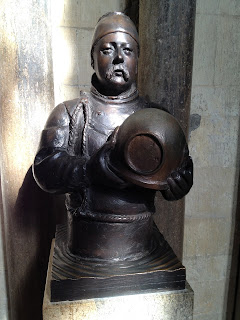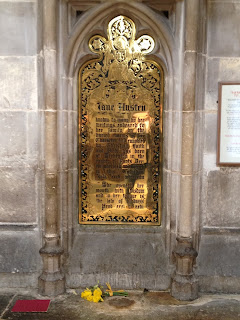
Winchester Cathedral stands in a green and tree lined close just a few minutes walk away from the High Street. I have loved visiting the cathedral since childhood days. Although Winchester does not have the magnificent towers of Lincoln or the tall spire of Salisbury, it is a fine and inspiring building with its beautiful nave and so many other features of architectural and historical importance.
Flash photography is not permitted inside the building , so the few inside images are from a mobile phone camera.
The main door beneath the West window.
The first cathedral church, now called the Old Minster, was built on this site by the Anglo Saxons, who completed their building in the 7th Century. After the Norman Conquest (1066) the cathedral was rebuilt ( completed in 1093) on its present large footprint, using many of the materials from the Saxon Minster. Below, the paved areas in front of the Norman North end show the site of the foundations of the Saxon Minster.
There have been changes and additions in subsequent centuries, but the interior of the cathedral is an awe inspiring and timeless space.
A drawing of the Old Minster.
The Nave of Winchester Cathedral, showing fan vaulting above the Choir.
Reflections of a stained glass window on a pillar in the Nave.
A statue of the early 20th century Naval diver William Walker, who saved the cathedral from subsidence by replacing rotting timbers in the foundations with concrete.
These medieval floor tiles are said to be the oldest still being walked upon in England.
Winchester was the Saxon capital of Wessex and of England. Raised above the Choir, are a series of Mortuary Chests which contain the bones of many of the Saxon Kings and early Bishops. I remember, as a young girl, being amazed and thrilled by being in the presence of the Kings and Queens we had learned about in school history lessons. That sense of wonder has never left me. So many centuries have passed since their time, yet still they here are!
This is one of a series of beautiful stained glass windows designed by the Pre Raphaelite painter William Morris.
The Font which has been used to baptise Winchester babies since the 1100s.
The early 19th century novelist Jane Austen is buried in Winchester Cathedral. She was brought to Winchester to seek medical care, but died in a house not far from the Cathedral, in the care of her beloved sister Cassandra. She did not achieve literary fame in her lifetime, so the words on her tomb tell of the loss of a much loved daughter, sister and aunt. The brass memorial plaque in the nearby wall was placed there at a much later date, to acknowledge her greatness as a writer. It was touching to see that someone had left a simple bunch of daffodils below her memorial.
The Cathedral is a treasure house of history. The Cathedral website explores its history in great detail and describes the part still played by the cathedral in the life of Winchester.
www.winchester-cathedral.org.uk
Outside in the Cathedral Close.......
The War Memorial and new nests in a nearby tree. Life goes on......
A Norman arched, leaded window.
The tower , shorter than that of many English cathedrals, seen from the south side of the close.







































































